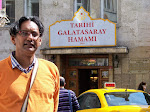The Russian Tea Room is a restaurant in New York City, located at 150 West 57th Street between Carnegie Hall Tower and Metropolitan Tower.
Entry to the Russian Tea Room in 2008The Russian Tea Room was opened in 1927, by former members of the Russian Imperial Ballet, as a gathering place for Russian expatriates and became famous as a gathering place for those in the entertainment industry. The founder is often considered to be Polish-born Jacob Zysman, but in that year, a corporation directory gives Albertina Rasch as the president and her name appears along with Russian Art Chocolate and Russian Tea Room, in early photographs of the shopfront at 145 W. 57th St. In 1929, the business moved across the street to its present location, which at that time was an Italianate brownstone, built in 1875 by German immigrant John F. Pupke, a tea and coffee merchant, whose son later moved the large clan to Long Island, seeking a more relaxed lifestyle.
By 1933, the Siberian émigré Alexander Maeef was running the Russian Tea Room and was the main personality associated with the restaurant for the next fifteen years.
In 1955, the restaurant was purchased by Sidney Kaye, who, in 1967, left the restaurant to his widow, Faith Stewart-Gordon.
In 1981, Harry B. Macklowe, the developer of the Metropolitan Tower, planned a large office tower that would have included not only his own site at the Metropolitan Tower, but also the restaurant's and the lot on which Carnegie Hall Tower was erected. There was an agreement with Carnegie Hall about their lot, but Stewart-Gordon, who owned the lot dividing the project, refused to sell. Macklowe also offered to buy the air rights only and to give room for her restaurant inside the new tower building, but Stewart-Gordon declined. No matter what she was offered, Stewart-Gordon refused to sell the lot. During the planning of the Carnegie Hall Tower at 152 W. 57th St., on the other side of the Russian Tea Room, again Stewart-Gordon declined to sell its site or its air rights. The result is the narrow twenty-foot gap, separating the Metropolitan and Carnegie Hall towers.
n December 1996, Warner LeRoy, who owned Tavern on the Green, bought the restaurant from Stewart-Gordon for $6.5 million and closed it down, much to the despair of New York high society.After four years and $36 million in renovations, it reopened, but it was never the same; it closed with little notice on Sunday, July 28, 2002, after declaring bankruptcy. LeRoy's health was failing. Also, the local economy did not recover quickly enough to make payments on the substantial loans for the renovations.
After Warner LeRoy died, his estate sold the property for $16 million to the United States Golf Association in December 2002. The Association had planned to reconfigure the property as a dining room and museum, in which to showcase its extensive collection of golf memorabilia, but instead it sold the building in 2004 to the RTR Funding Group of Gerald Lieblich.The 20-foot-wide building goes all the way from 57th St. (the restaurant's main entrance) to 56th St. The plans are to replace some of the current building facing 56th St. with a 29-storey condominium, which is to be designed by Costas Kondylis. The original restaurant will be kept undisturbed.
The Russian Tea Room reopened on November 1, 2006. The restaurant's interior hasn't been touched and the over-the-top decor is the same as when it closed in 2002.However, several restaurant reviews have noted that the food and service leave significant room for improvement.
Subscribe to:
Post Comments (Atom)






No comments:
Post a Comment